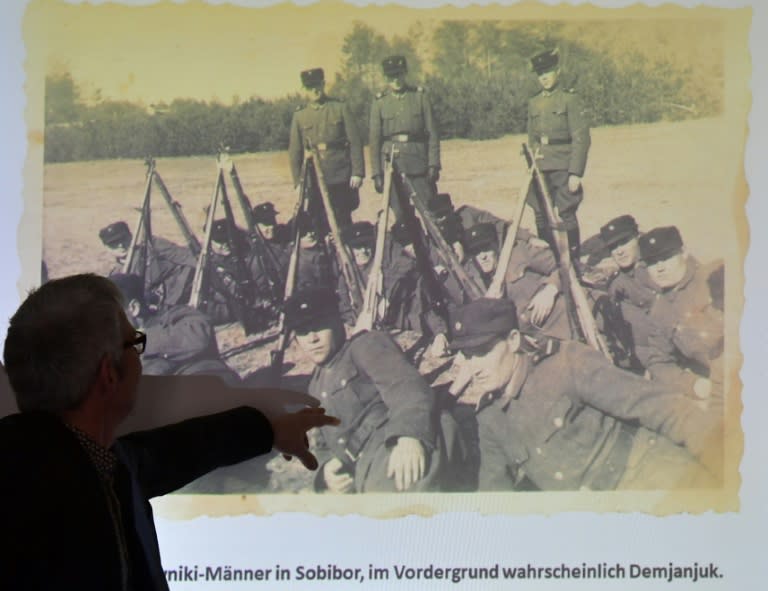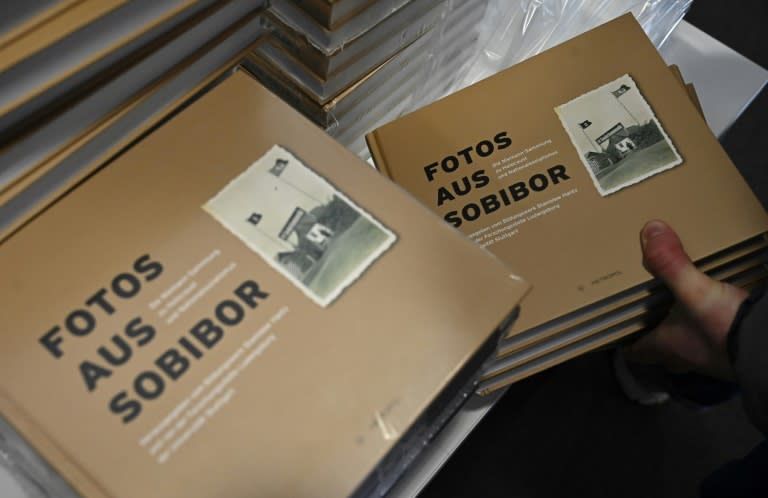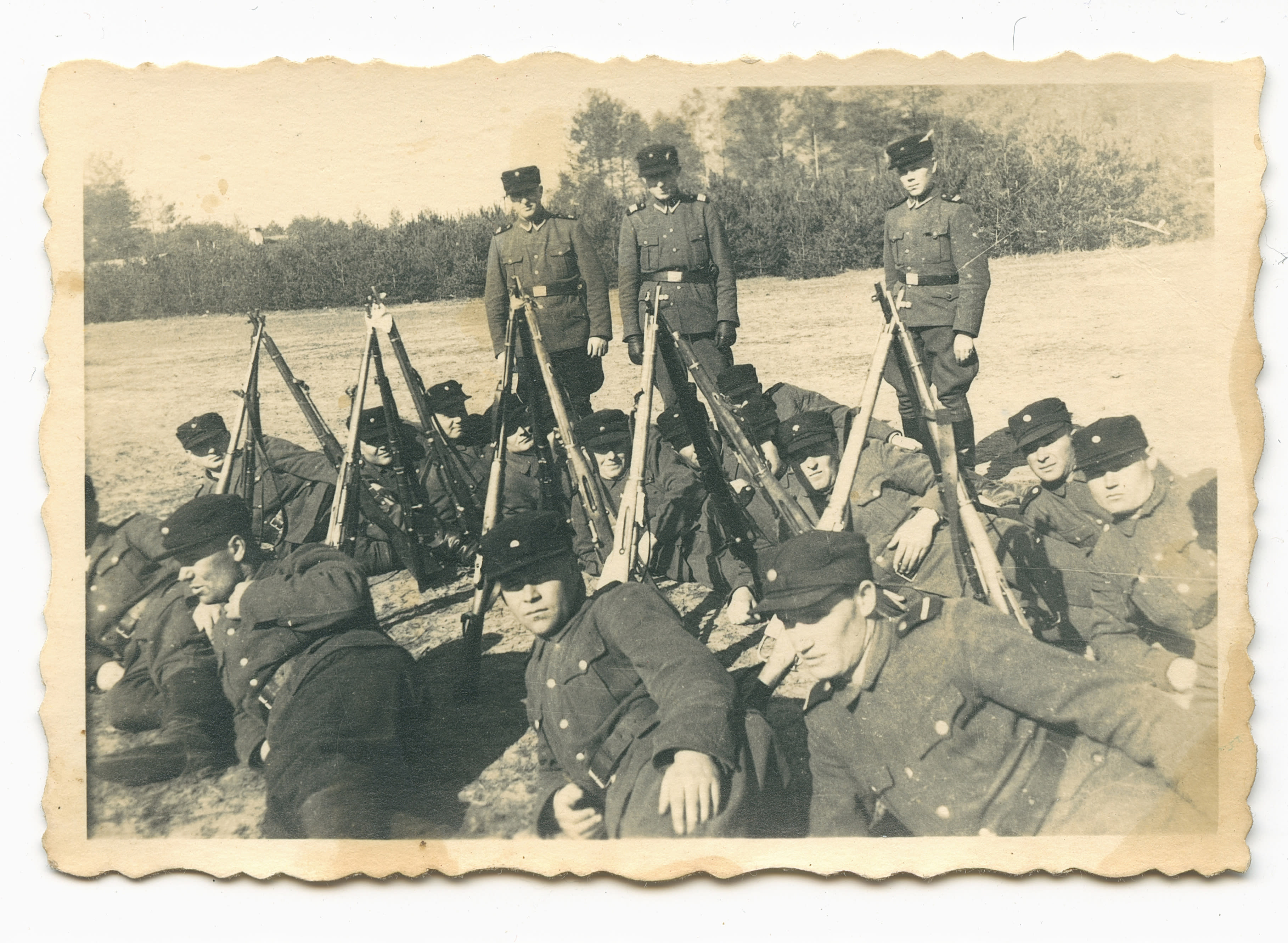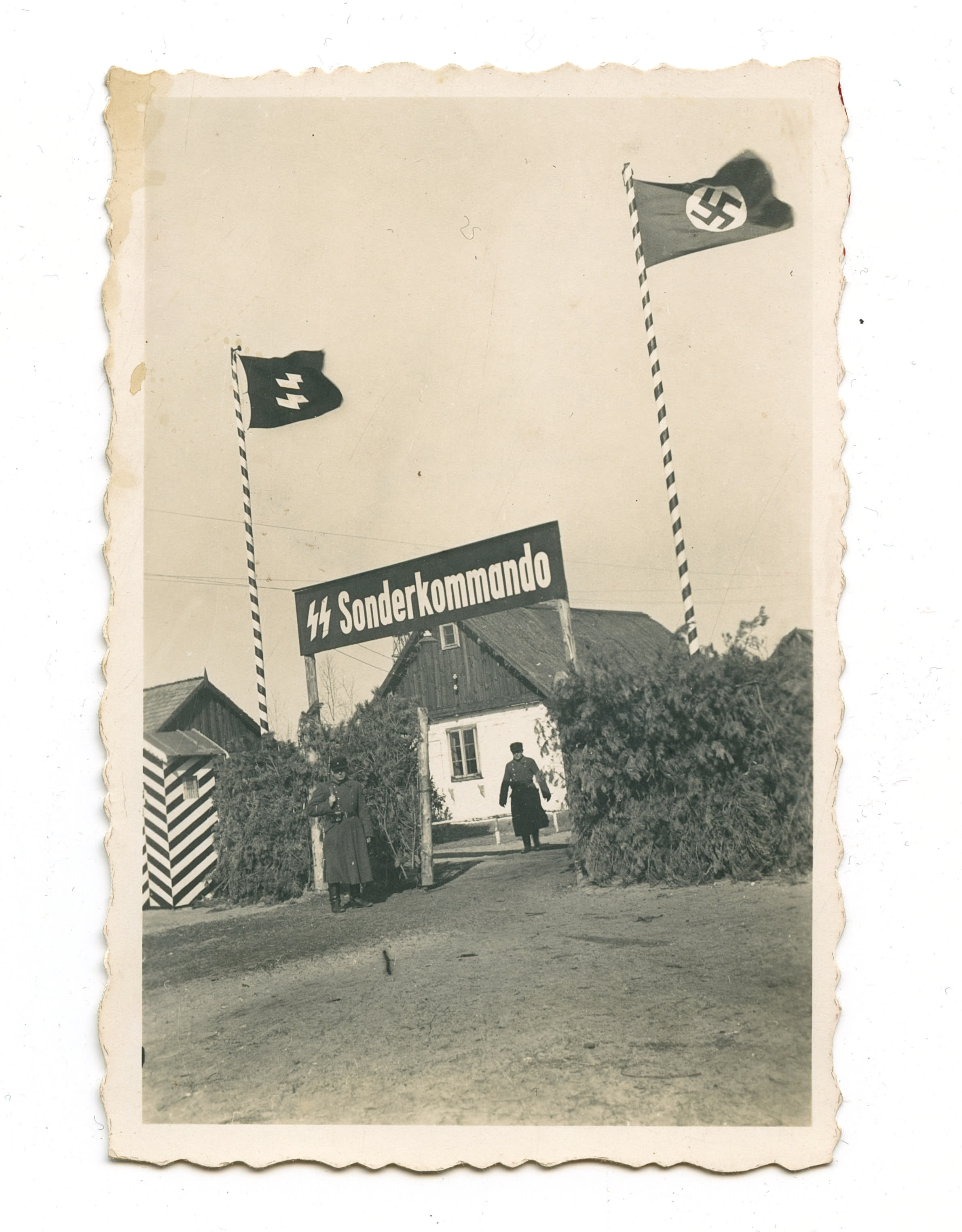Yannick PASQUET, AFP•January 28, 2020

A staff member of the Topography of Terror archive points at a historical photograph allegedly showing convicted Nazi guard John Demjanjuk at the Sobibor camp (AFP Photo/Tobias SCHWARZ) 1 / 2
Berlin (AFP) - Hundreds of newly discovered photographs, including some taken at the Sobibor death camp, represent a "quantum leap" in research into Nazi crimes against humanity, historians at the Berlin museum Topography of Terror said Tuesday.
Historians said the "exceptional collection" provided unprecedented insights into the Sobibor camp in German Nazi-occupied Poland, about which little is known even 75 years after the end of World War II.
The trove, consisting of 361 black-and-white photos and several written documents, also includes photos believed to show convicted Nazi guard John Demjanjuk, who denied ever being at Sobibor.
The photos were discovered by a descendant of SS officer Johann Niemann and handed over to Martin Cueppers, a historian at the University of Stuttgart, in 2015 who studied the material.

"This collection represents a quantum leap in our visual knowledge of the Holocaust in occupied Poland," Cueppers said at a press conference at the Topography of Terror, an archive and museum at the site of the former Gestapo headquarters in Berlin.
Around 1.8 million Jews died at Belzec, Treblinka and Sobibor in Poland as part of "Operation Reinhard", yet knowledge about the latter camp has been scarce.
Where previously there had been only two surviving photos from Sobibor, the Niemann collection threw up a further 49 snapshots, said Stefan Haenschen from the Stanislaw Hantz organisation which runs tours at the camp.
Haenschen said the photos offered a chance to "widen public awareness" of a Nazi crime which was "still under-represented".
- Demjanjuk case -
There are two photos in the collection which Cueppers said "probably" showed John Demjanjuk at Sobibor.
The historians were cautious however, saying that they could not be totally certain the photos showed the convicted Nazi guard.
Ukrainian-American Demjanjuk was convicted of being an accessory to the murder of nearly 30,000 Jews at Sobibor by a German court in 2011. He died while his appeal was pending.
Born in Ukraine in 1920, Demjanjuk emigrated to the United States after war.
In 1986, he stood trial in Jerusalem accused of being "Ivan the Terrible," an infamous Ukrainian guard at another death camp, Treblinka.
An initial death sentence was overturned by the Israeli supreme court in 1993.
But after evidence emerged that he served as a guard at other Nazi camps, Demjanjuk was stripped of his US citizenship in 2002 for lying about his war record on immigration forms.
Extradited to Germany in 2009, he was later sentenced to five years in prison in a landmark case for the German justice system.
The court ruled that as a guard at the camp, he was automatically implicated in killings carried out there at the time.
The case set a new legal precedent and prompted several further convictions of Nazi officers, including that of the "bookkeeper of Auschwitz" Oscar Groening, on the basis they served as cogs in the Nazi killing machine.
In 2019, Demjanjuk was the subject of the Netflix documentary "The Devil Next Door".
Nazi camp commander’s photos thought to show war crimes convict John Demjanjuk
By Kerstin Sopke and Geir Moulson, Associated Press
,PA Media: World News•January 28, 2020
Historians have presented a collection of photos kept by the deputy commander of the Nazis’ death camp that they say appears to include images of John Demjanjuk, the retired US car worker who was tried in Germany for his alleged time as a Sobibor guard.
The collection unveiled on Tuesday at Berlin’s Topography Of Terror museum comprises 361 photos as well as written documents illustrating Johann Niemann’s career. Niemann was the deputy commander of Sobibor from September 1942 until he was killed on Oct. 14, 1943 in an uprising by Jewish inmates.
Unlike in many other cases, the photos were not destroyed after the Second World War in fear of legal proceedings, and they remained in the possession of Niemann’s family.
The collection is being handed over to the US Holocaust Memorial Museum.
Experts say the collection enhances historians’ knowledge of what Sobibor looked like.
So far, they knew of only two photos taken of the camp while it existed.
The Niemann collection adds another 49.

Historican Martin Cueppers points at a man thought to be John Demjanjuk (Markus Schreiber/AP)
Anne Lepper, whose grandparents were murdered on arrival at Sobibor from the Netherlands in 1943, said it was “very courageous” of Niemann’s descendants to release the photos.
She said it was “a breathtaking experience” to see the images after frequently having seen the site.
The collection may also shed more light on Demjanjuk, who was convicted in 2011 as an accessory to murder on allegations he served as a Sobibor guard.
Demjanjuk always denied the accusations and died in 2012 before his appeal against the ruling by a Munich court could be heard, making the verdict not legally binding.
Two photos in the collection may depict a young Iwan Demjanjuk, as he was known before anglicising his name to John, among other former prisoners of war who were trained at an SS camp and were deployed at Sobibor, according to historians.
If they do, they would be the first to prove that he was at the camp.
Martin Cueppers, a Holocaust historian at the University of Stuttgart, said researchers concluded that Demjanjuk is “probably” depicted at least in one case in conjunction with the criminal police office in Germany’s Baden-Wuerttemberg state, whose biometric department agreed to examine the historical photos.
But Demjanjuk’s son, John Demjanjuk Jr, said of the newly unveiled photos that “it’s a baseless theory to claim they prove anything at all regarding my father”.
The collection as a whole is “of significant historical value” regarding the Holocaust and Sobibor, he said in a statement.
But “the photos are not proof of my father being in Sobibor and may even exculpate him once forensically examined”.
Historians: Sobibor death camp photos may feature Demjanjuk
KERSTIN SOPKE and GEIR MOULSON,Associated Press•January 28, 2020

This spring 1943 photo provided by the U.S. Holocaust Memorial Museum shows a group of auxiliary guards at the Nazi death camp Sobibor in German-occupied Poland. A Holocaust historian said researchers concluded that John Demjanjuk, the retired Ohio auto worker who was tried in Germany for his alleged time as a Sobibor guard, is presumably depicted in this photo. (U.S. Holocaust Memorial Museum via AP)
1 / 6

BERLIN (AP) — Historians have presented a collection of photos kept by the deputy commander of the Nazis' Sobibor death camp that they say appears to include images of John Demjanjuk, the retired Ohio auto worker who was tried in Germany for his alleged time as a Sobibor guard.
The collection unveiled Tuesday at Berlin's Topography of Terror museum comprises 361 photos as well as written documents illustrating Johann Niemann's career. Niemann was the deputy commander of Sobibor from September 1942 until he was killed on Oct. 14, 1943, in an uprising by Jewish inmates.
Unlike in many other cases, the photos were not destroyed after World War II in fear of legal proceedings, and they remained in the possession of Niemann's family. The collection is being handed over to the U.S. Holocaust Memorial Museum.
Experts say the collection enhances historians' knowledge of what Sobibor looked like. So far, they knew of only two photos taken of the camp while it existed. The Niemann collection adds another 49.
Anne Lepper, whose grandparents were murdered on arrival at Sobibor from the Netherlands in 1943, said it was “very courageous” of Niemann's descendants to release the photos. She said it was “a breathtaking experience” to see the images after frequently having seen the site.

The collection may also shed more light on Demjanjuk, who was convicted in 2011 as an accessory to murder on allegations he served as a Sobibor guard. Demjanjuk always denied the accusations and died in 2012 before his appeal against the ruling by a Munich court could be heard, making the verdict not legally binding
Two photos in the collection may depict a young Iwan Demjanjuk, as he was known before anglicizing his name to John, among other former prisoners of war who were trained at an SS camp and were deployed at Sobibor, according to historians. If they do, they would be the first to prove that he was at the camp.
Martin Cueppers, a Holocaust historian at the University of Stuttgart, said researchers concluded that Demjanjuk is “probably” depicted in at least one case in conjunction with the criminal police office in Germany's Baden-Wuerttemberg state, whose biometric department agreed to examine the historical photos.
But Demjanjuk's son, John Demjanjuk Jr., said of the newly unveiled photos that “it’s a baseless theory to claim they prove anything at all regarding my father.”
The collection as a whole is “of significant historical value" regarding the Holocaust and Sobibor, he said in a statement emailed to The Associated Press. But “the photos are not proof of my father being in Sobibor and may even exculpate him once forensically examined.”
The Ukrainian-born Demjanjuk was a Soviet Red Army soldier captured by the Germans in Crimea in 1942. He was accused of agreeing to serve as a "Wachmann," or guard, the lowest rank of the "Hilfswillige," former POWs who were subordinate to German SS men, and training in a camp known as Trawniki.
The Munich court said the evidence showed he was a part of the Nazis' "machinery of destruction" and served in Sobibor from March 27, 1943, until mid-September that year.
Integral to the prosecution's case was an SS identity card that allegedly shows a picture of a young Demjanjuk and indicates he trained at the SS Trawniki camp and was posted to Sobibor.
Though court experts said the card appears genuine, Demjanjuk's defense attorneys argued it was a fake produced by the Soviet KGB.
The prosecution also produced evidence including transfer lists indicating a guard named Demjanjuk with the same Trawniki number was sent to serve in Sobibor and elsewhere, but there was never photographic proof he was there.
Between March 1942 and October 1943, about 167,000 people were killed at Sobibor, almost all Jews, according to the U.S. Holocaust Memorial Museum. Following the 1943 uprising, the Nazi guards shot the remaining prisoners and razed the camp in occupied Poland.
Demjanjuk always maintained he was a victim of the Nazis, first wounded as a Soviet soldier and then captured and held as a prisoner of war under brutal conditions before joining the Vlasov Army, a force of anti-communist Soviet POWs and others formed to fight with the Germans against the Soviets in the war's final months.
If the newly surfaced photographs turn out not to picture Demjanjuk, it wouldn't be the first time his identity has been mistaken.
In the 1980s, Demjanjuk stood trial in Israel after he was accused of being the notoriously brutal guard "Ivan the Terrible" at the Treblinka extermination camp. After Treblinka survivors identified him as their tormentor, he was convicted and sentenced to death — but then freed when an Israeli court overturned the ruling, saying the evidence showed he was the victim of mistaken identity.
___
David Rising in Dubai, United Arab Emirates, contributed to this report.
No comments:
Post a Comment